GEOMETRY PROPERTIES OF PARALLELOGRAMS
Subscribe to our ▶️ YouTube channel 🔴 for the latest videos, updates, and tips.
Subscribe to our ▶️ YouTube channel 🔴 for the latest videos, updates, and tips.
Properties of Parallelogram
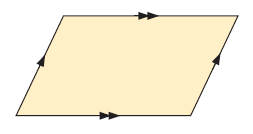
In parallelogram, opposite sides are parallel and equal.
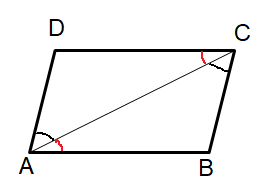
Here diagonal is like a transversal for parallel lines. Then alternate interior angles are equal.
That is,
∠DAC = ∠ACB, ∠DCA = ∠CAB
Since the opposite sides are parallel, we observe the same side interior angles.
∠DAB + ∠ADC = 180
∠DCB + ∠CBA = 180
Conclusion :
- Opposite sides are equal
- Opposite angles are equal
- Sum of consecutive interior angles will be 180 degree.
- Diagonals will bisect each other.
Problem 1 :
In the parallelogram shown below, find the value of x.
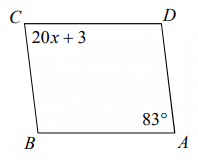
Opposite angles are equal.
20x + 3 = 83
20x = 83 - 3
20x = 80
x = 80/20
x = 4
Problem 2 :
Quadrilateral RSTU is a parallelogram. Find the values of x, y, a, and b.
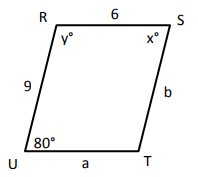
Solution :
Here some angles are missing and some side lengths is also missing.
In parallelogram, opposite sides are equal, opposite angles are equal and consecutive interior angles add upto 180 degree.
80 and y are consecutive interior angles.
80 + y = 180
y = 180 - 80
y = 100
x = 80 (opposite angles)
b = 9 and a = 6
Problem 3 :
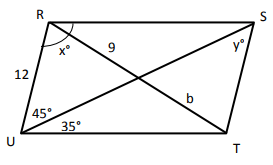
Solution :
y = 35
∠SRU + ∠RUT = 180
x + 45 + 35 = 180
x + 80 = 180
x = 180 - 80
x = 100
Problem 4 :
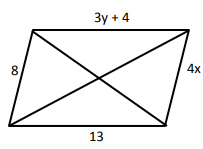
Solution :
Opposite sides are equal.
|
3y + 4 = 13 3y = 13 - 4 3y = 9 y = 9/3 y = 3 |
4x = 8 x = 8/4 x = 2 |
Problem 5 :
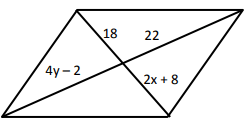
Solution :
Diagonals will bisect each other.
|
2x + 8 = 18 2x = 18 - 8 2x = 10 x = 10/2 x = 5 |
4y - 2 = 22 4y = 22 + 2 4y = 24 y = 24/4 y = 6 |
Problem 6 :
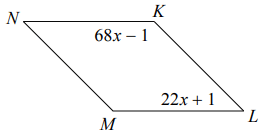
Solution :
Sum of consecutive angles = 180
68x - 1 + 22x + 1 = 180
90x = 180
x = 180 / 90
x = 2
Problem 7 :
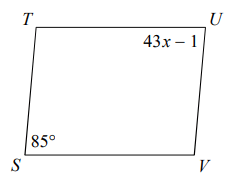
Solution :
∠TUV = ∠TSV
43x - 1 = 85
43x = 85 + 1
43x = 86
x = 86/43
x = 2
Problem 8 :
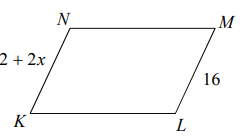
Solution :
MK = ML
2 + 2x = 16
2x = 16 - 2
2x = 14
x = 14/2
x = 7
Problem 9 :
Find angle F.
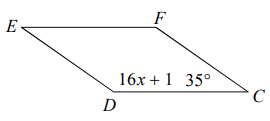
Solution :
Sum of consecutive angles = 180
16x + 1 + 35 = 180
16x + 36 = 180
16x = 180 - 36
16x = 144
x = 144/16
x = 9
∠F + ∠C = 180
∠F + 35 = 180
∠F = 180 - 35
∠F = 145
Problem 10 :
Find angle measure R.
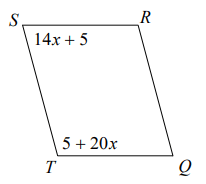
Solution :
Sum of consecutive angles = 180
14x + 5 + 5 + 20x = 180
34x + 10 = 180
34x = 180 - 10
34x = 170
x = 170/34
x = 5
Recent Articles
-
Finding Range of Values Inequality Problems
May 21, 24 08:51 PM
Finding Range of Values Inequality Problems -
Solving Two Step Inequality Word Problems
May 21, 24 08:51 AM
Solving Two Step Inequality Word Problems -
Exponential Function Context and Data Modeling
May 20, 24 10:45 PM
Exponential Function Context and Data Modeling